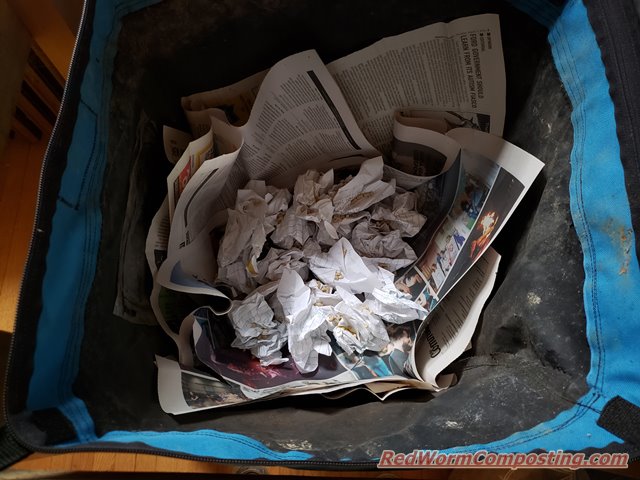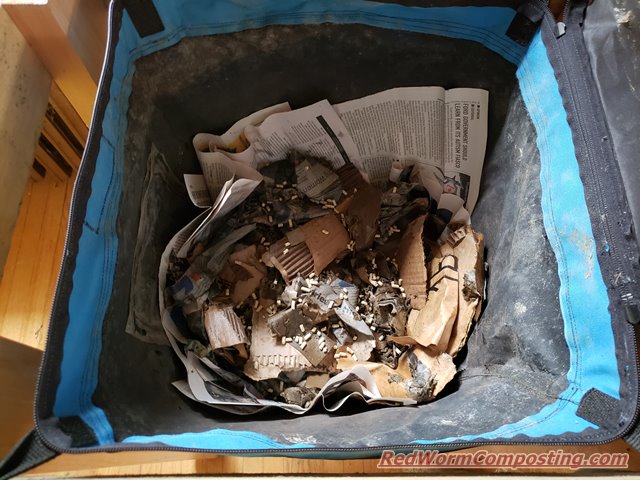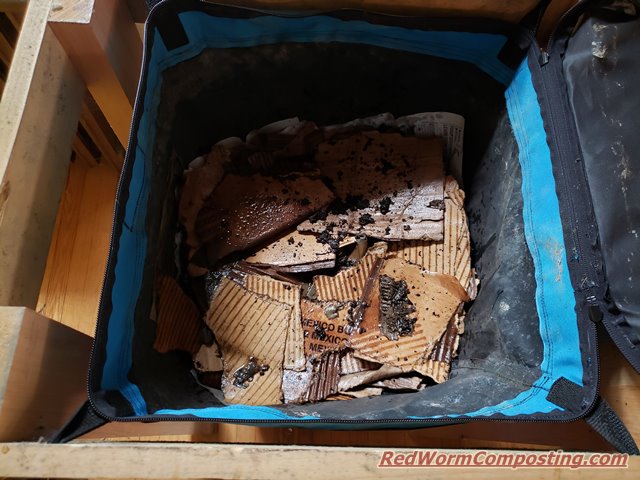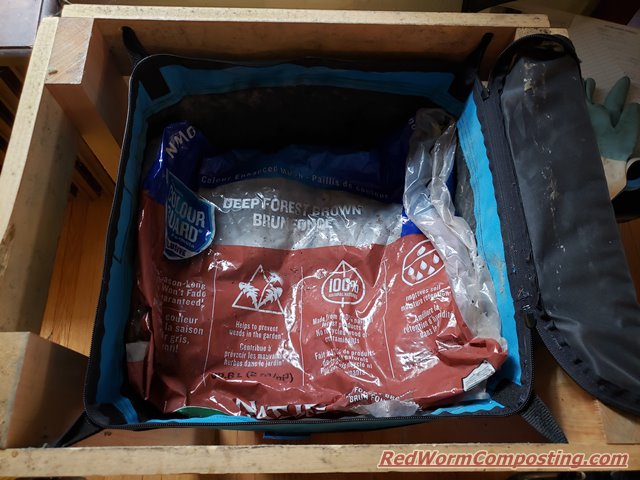
Last week I started the process of getting one of my VermiBags up and running again.
I know.
It must seem like there is a bit of a Red Worm Composting worm bag renaissance going on around here! (And in fact, I even have plans to get at least one of my old Worm Inns up and running as well. lol)
This flurry of new vermicomposting activity, which includes my worm bag mania, relates to my spending a lot more time over at my dad’s place (where I keep most of my indoor vermicomposting systems/supplies) in recent weeks.
Hopefully the trend continues, since it is starting to feel like “the good ol’ days” of RWC (and then some)!
😉
Last week I simply wanted to get the system ‘brewing’ a bit, so I just added some moistened bedding and poultry feed to kickstart microbial growth (we’ll come back to this in a minute).
I started by filling the lower reaches with “scrunched” paper – this could have just as easily been shredded cardboard/newsprint, or really, anything rich in carbon with good moisture holding capacity.

Then, added my sheets of newsprint…

…and more scrunched paper

Next it was some soggy box cardboard (which had actually been ‘brewing’ a bit already in another system) and some of the poultry feed pellets…

…more soggy cardboard…

…a plastic bag to keep in moisture…

… and the screen lid zipped up over top.

I left everything sat for 6 days (while I busily set up other systems – lol).
During this period I firmed up my plans to make this a bit more of a “vermiculture” experiment than vermicomposting. Goodness knows, I’m gonna end up with a food scrap shortage in the months ahead with all the systems I’m setting up. So, I figured why not try a super simple approach – only using paper-based bedding materials (cardboard, paper, newsprint) and poultry feed.
IMPORTANT NOTE – This is usually the point at which the vermicomposting purists can turn up their noses, based on some of the conversation threads I’ve seen in the RWC Facebook group. The idea of actually buying something to use as a worm food somehow “defeats the purpose” in their minds.
I get it, to a certain extent – but also know that mastery of vermiculture (raising worms), “worm husbandry” if you prefer, is a hugely important part of the equation. Becoming a bit of a worm-raising ‘geek’ is not only fun and educational, but it can greatly increase your chances of success with vermicomposting as a whole – thus the overall positive impact you can end up making!
And of course, it also makes perfect sense if you happen to have any sort of interest in worm farming as a business (or using lots of worms for other purposes).
Bottom-line, don’t be a vermicomposting snob! It’s the last thing the worm world needs.
(Ok, getting down off my worm bin now – haha)
Getting back to my system set up…
Yesterday, I added some worm-rich bedding/habitat material from an active system, added a bit of water, and covered over with a layer of dry shredded newsprint (before putting back my plastic bag, and once again zipping up the screen lid)


I am really interested to see how productive this system gets. Will there be loads of Red Worms? Will I end up with big Red Worms? How will this exclusive diet affect the overall health of the worms?
Should be interesting to see how things pan out!
😎

This could also serve as a great tutorial on what to do with expired or otherwise unusable for their original purpose: grains, bird seed, sacks of animal feed, etc. Which is information harder to break into easy information for a new worm herder’s bin that is also fed scraps. So usually the advice is to throw it out.
I like that you didn’t use any machine shredded (I think?) materials in this VermiBag (Mini?). The only thing that might be inaccessible is the worm rich material, but a new person should get something like that with their first worm order. Perhaps less of the other helpful life forms for the first few weeks, as those recover from dry shipping conditions, but eventually it should be a well populated bin!
Hi Zanne – I always feel very uncomfortable when I see people talk about “throwing out” ANY form of organic matter (and it is still sad to see it happen so often) , so you are making an excellent point here!
No machine shredding for me – other than some stuff I make with my mulching mower (should be writing about that soon). I’ve been tempted to get a really nice paper shredder (that can handle cardboard) but there is also something satsifying about doing it by hand (especially while watching movies or educational videos)!
There are a wide range of living materials “out there” – but they certainly do become more difficult to track down during the winter in many locations. Good news is that it simply takes a bit of time for newbies to make their own in a vermicomposting system. Microbes are everywhere – so it’s really just a matter of time!
😎
Bentley; Any shredder will do cardboard. If the cardboard is too thick for the feed slot, then just separate the layers.
Hey Shaul – I’ve definitely owned shredders that won’t handle cardboard, and it’s the layer the worms really seem to love about the corrugated stuff. The be on the safe side, one that claims 20 sheet shredding or higher is a good way to go in my humble opinion – and I’ve seen them for a reasonable price (unlike the crazy industrial grade ones lol).
😎
I have an old worm inn and a worm inn Mega. They hang together in a closet in my basement. There are no wrong ways to use a worm inn except by not using enough water. But I will tell you how I use mine. I only empty them once a year in the spring when I use the castings in various ways in my garden. I empty from the bottom about 3/4 of the material, and yes there are some worms in mix. I don’t worry about them because they end up in my raised gardens. I only use leaf mold that is not composted completely along with food scraps for feeding. I found that top feeding with bedding cover left an inch or two of dry not composted material all around the edges of my inns, So now I mix leaf mold and food scraps together {like your home made manure} and dig down along one side of the bin, pour the mix in and cover it over, no top covering of anything. I only feed about once every two weeks so I water well at feeding. {about a pint of water in each inn}. Winter time of course uses more water when furnace is running. I love these Worm Inns, they work for me. Thank you for selling them to me! The product that comes out is outstanding! When people see my gardens they all ask me how I can grow such huge tomatoes and peppers. It makes me smile!
John
This is great, John! Leaf mold would be an excellent living material so I can see how mixing with your food materials would be a really effective strategy. Thanks for sharing!
😎